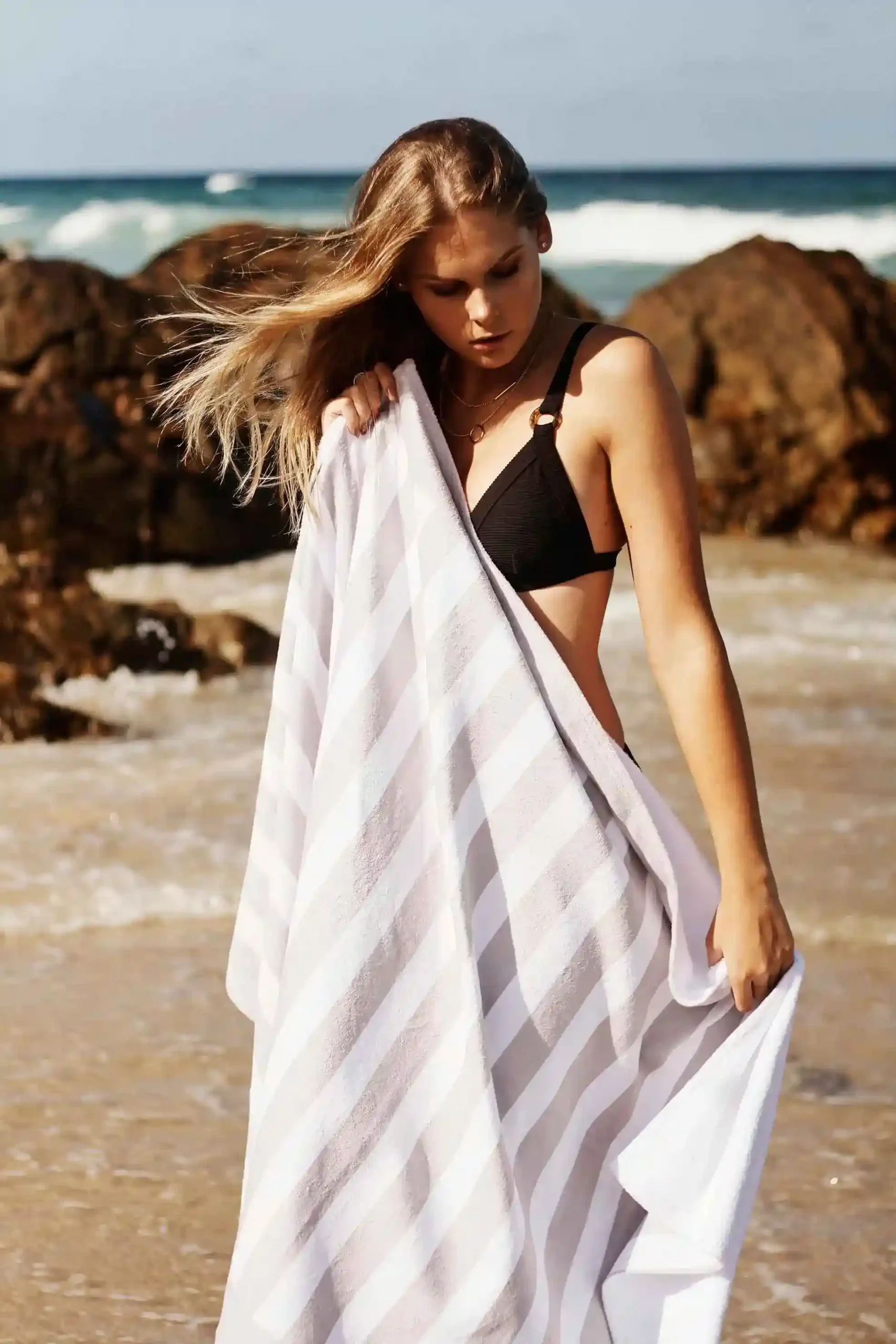Stripes are a pattern that has stood the test of time. From the iconic Breton tops worn by sailors to the bold stripes on a runway, this simple yet versatile pattern has woven its way into our hearts and closets. But what is it about stripes that makes them so timeless? In this guide, we’ll explore the charm of stripes, how to style them, and why they continue to be a favorite in fashion. Whether you’re a stripe newbie or a seasoned fan, there’s something here for everyone.
The Allure of Stripes: Why We Love Them
Stripes are more than just a pattern; they’re a statement. According to fashion icon Iris Apfel, “Stripes are a timeless pattern that can be incorporated into any wardrobe. They add a touch of chic and personality” (Harper’s Bazaar). Stripes can be bold or subtle, playful or serious, making them incredibly versatile.
One of the reasons stripes have remained popular for so long is their ability to adapt to different styles and occasions. A simple striped tee can be dressed down with jeans for a casual look or paired with a blazer for something more polished. Stripes can also be used to create visual effects, such as elongating the body or adding a sense of structure to an outfit. As fashion expert Tan France explains, “Stripes can be a great tool for body contouring. Vertical stripes can elongate the figure, while horizontal stripes can create a wider appearance” (Fashionista).
I remember my first striped piece—a classic navy and white Breton top. I was hesitant at first, thinking stripes might be too bold for my style. But once I tried it on, I was hooked. The stripes added a level of sophistication to my outfit that I hadn’t expected. It became a go-to piece in my wardrobe, and I found myself reaching for it time and time again.
Styling Stripes: Tips and Tricks
Stripes might seem straightforward, but there are a few tips and tricks to keep in mind to make the most of this classic pattern. Here are some expert-approved ways to style stripes:
1. Play with Proportions
One of the most fun aspects of stripes is the ability to play with proportions. Stella McCartney, a renowned fashion designer, advises, “Playing with different stripe widths and colors can create endless possibilities. It’s all about finding the right combination for your personal style” (Top Fashion Designers).
For a modern look, try mixing wide and narrow stripes in the same outfit. This can add depth and interest to your look without overwhelming it. If you’re feeling adventurous, experiment with mixing stripes of different colors or even pairing stripes with other patterns, like florals or polka dots.
2. Consider the Direction of the Stripes
The direction of the stripes can make a big difference in how they look on your body. Vertical stripes are known for their slimming effect, while horizontal stripes can make you appear wider. This doesn’t mean you should avoid horizontal stripes altogether—it’s all about balance. For example, if you’re worried about looking wider, opt for thinner horizontal stripes or pair them with solid-colored pieces to break up the pattern.
3. Mind the Colors
The color of your stripes can also impact your overall look. A color psychologist (hypothetical) notes, “The color of stripes can influence mood and perception. Bold stripes can create a strong statement, while softer stripes offer a more subtle look” (Wordstream).
If you’re new to stripes, start with classic colors like black, navy, or red. These shades are easy to style and work well with a variety of other colors. Once you’re comfortable, you can branch out into more vibrant hues or even multi-colored stripes for a bolder look.
4. Accessorize Thoughtfully
When wearing stripes, accessories can make or break your outfit. Tan France suggests, “Accessorizing with stripes is key. A striped top can be paired with solid-colored bottoms, or vice versa. Experiment with different accessories to complete the look” (Fashionista).
For example, a striped dress can be elevated with a simple belt to define your waist or a statement necklace to draw attention to your neckline. When it comes to bags and shoes, try to keep them neutral if you’re wearing bold stripes to avoid clashing patterns.
5. Don’t Be Afraid to Experiment
Fashion is all about self-expression, and stripes are a great way to experiment with your style. As Leandra Medine, a fashion blogger, points out, “Mixing and matching stripes with other patterns can be a bold fashion statement. Experiment with different combinations to find your signature style” (Fashionista).
Don’t be afraid to step outside of your comfort zone and try something new. Whether it’s a striped jumpsuit or a blazer with contrasting stripes, the possibilities are endless.
Stripes in History: A Pattern with a Past
Stripes have a rich history that adds to their timeless appeal. From their origins as a symbol of rebellion to their modern-day status as a fashion staple, stripes have always had a story to tell.
1. Maritime Roots
Stripes first became popular in the fashion world thanks to sailors. The classic Breton stripe, named after the Brittany region of France, was originally worn by French sailors in the 19th century. The pattern made it easier to spot sailors if they fell overboard, but it quickly became a fashion statement thanks to its clean, nautical look.
2. Stripes as a Symbol of Rebellion
In the 18th and 19th centuries, stripes were often associated with outcasts and rebels. Prisoners, prostitutes, and other marginalized groups were sometimes forced to wear stripes as a way to mark them as different from society. Over time, this association with rebellion made stripes a symbol of nonconformity and self-expression.
3. Stripes in Pop Culture
Stripes have had their moments in pop culture as well. From the iconic prison uniforms in movies to the bold stripes worn by rock stars in the 1960s and 70s, this pattern has always had a place in the spotlight. Today, stripes continue to be a favorite among fashion-forward celebrities and influencers, proving that they are as relevant as ever.
4. Stripes in High Fashion
Stripes have also made their way into high fashion, with designers like Coco Chanel and Jean Paul Gaultier embracing the pattern in their collections. Chanel famously introduced the striped Breton top to women’s fashion in the 1910s, pairing it with wide-leg trousers for a chic, relaxed look. Gaultier, on the other hand, has made stripes a signature of his brand, often incorporating them into his avant-garde designs.
As a fashion historian (hypothetical) notes, “Stripes have a rich history in fashion, appearing in various cultures and periods. They symbolize everything from maritime themes to rebellion” (Crafts Council).
The Psychology of Stripes: Why They Work
Stripes aren’t just visually appealing—they also have a psychological impact that makes them so effective in fashion. According to studies on fashion and consumer behavior, patterns like stripes can influence how we perceive ourselves and others.
1. Stripes and Body Image
One study found that clothing choices, such as striped patterns, can impact body image and self-esteem (Journal of Consumer Research). Vertical stripes, in particular, can create a slimming effect that makes the wearer feel more confident. On the other hand, horizontal stripes can add volume, which can have either a positive or negative effect depending on the individual’s body type and personal preferences.
2. Stripes and Mood
The color and spacing of stripes can also influence our mood. Bold, contrasting stripes can create a sense of excitement and energy, while softer, more subdued stripes can have a calming effect. This is why stripes are often used in different settings, from high-energy environments like sports uniforms to more relaxed spaces like home decor.
3. Stripes and Cultural Identity
Stripes can also play a role in cultural identity. In some cultures, stripes are associated with specific groups or traditions, such as the Breton stripes in France or the kente cloth in Ghana, which often features striped patterns. This cultural significance adds another layer of meaning to this timeless pattern, making it more than just a fashion choice but a statement of identity as well.
4. The Influence of Social Media
In today’s digital age, social media has a significant impact on fashion trends, including the popularity of stripes. According to a study on the impact of social media on fashion trends (Journal of Advertising Research), platforms like Instagram and Pinterest play a crucial role in spreading fashion trends and influencing consumer behavior. The hashtag #stripes has millions of posts, showcasing the versatility and appeal of this pattern. From influencers sharing their favorite striped looks to everyday fashion enthusiasts showing off their outfits, social media has helped stripes remain a staple in fashion.
Stripes in My Life
Stripes have always been a go-to pattern for me, whether I’m dressing for a casual day out or a special occasion. One of my favorite striped pieces is a vintage dress I found at a thrift store. It’s a simple A-line dress with navy and white stripes, and every time I wear it, I feel effortlessly chic. The dress has a timeless quality that makes it appropriate for almost any occasion, and I love the way the stripes elongate my figure.
Another stripe-related memory I cherish is from a family vacation to the coast. We all wore matching Breton tops, a nod to the maritime tradition of stripes. The photos from that trip are some of my favorites, not just because of the beautiful scenery but because the stripes added a sense of unity and fun to our outfits.
Stripes have a way of making even the simplest outfit feel special. Whether it’s a classic striped tee or a bold, multi-colored dress, stripes add a touch of personality that never goes out of style.




